Navigating Transitions 2018: Falls Prevention Workbook
VerifiedAdded on 2023/06/03
|7
|2826
|223
Homework Assignment
AI Summary
This assignment is a learning resource workbook developed by a student, focusing on falls prevention in aged care settings. The workbook targets Assistant in Nursing (AIN) professionals and aims to equip them with knowledge and skills to assist Registered Nurses in implementing exercise interventio...
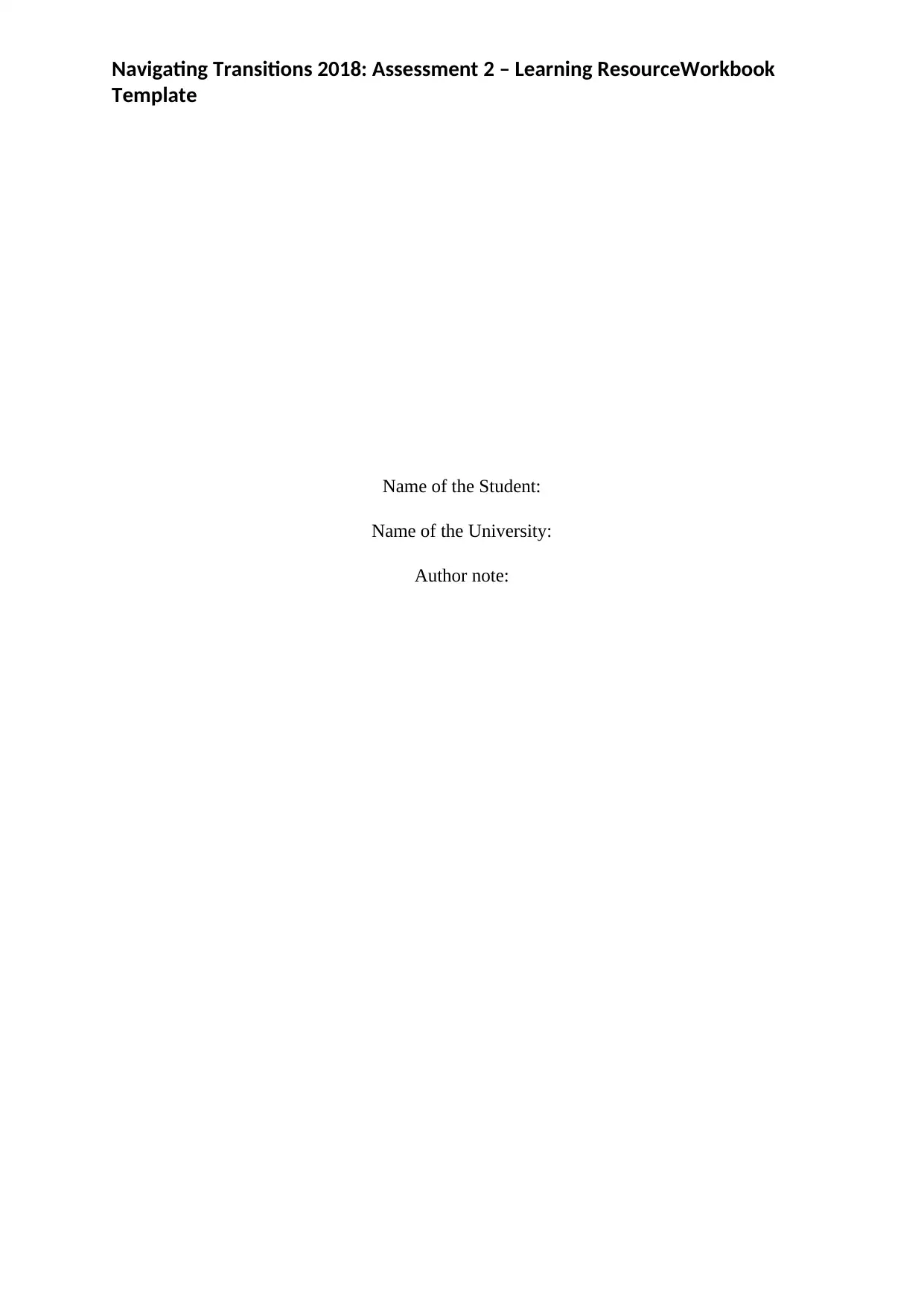
Navigating Transitions 2018: Assessment 2 – Learning ResourceWorkbook
Template
Name of the Student:
Name of the University:
Author note:
Template
Name of the Student:
Name of the University:
Author note:
Paraphrase This Document
Need a fresh take? Get an instant paraphrase of this document with our AI Paraphraser
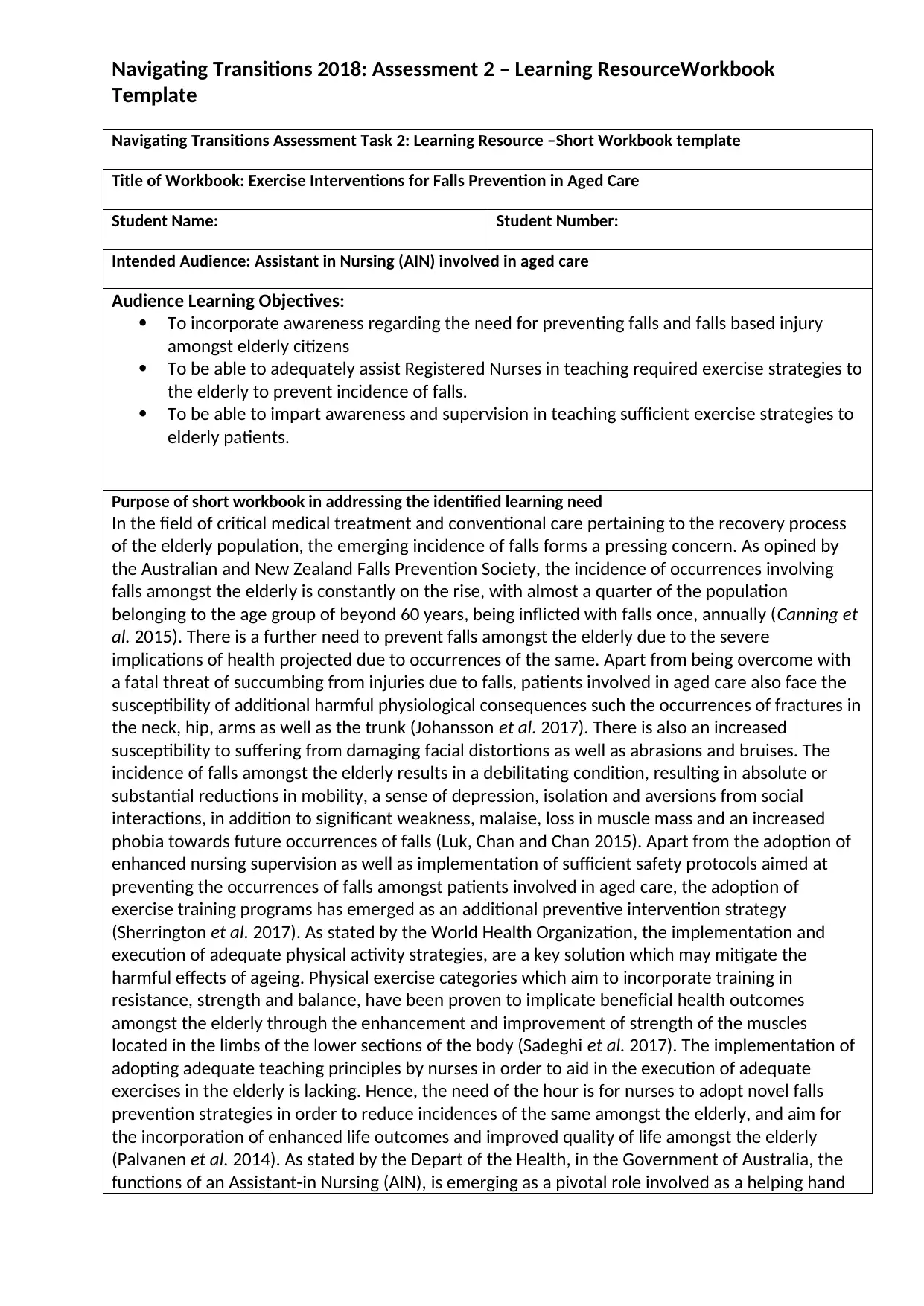
Navigating Transitions 2018: Assessment 2 – Learning ResourceWorkbook
Template
Navigating Transitions Assessment Task 2: Learning Resource –Short Workbook template
Title of Workbook: Exercise Interventions for Falls Prevention in Aged Care
Student Name: Student Number:
Intended Audience: Assistant in Nursing (AIN) involved in aged care
Audience Learning Objectives:
To incorporate awareness regarding the need for preventing falls and falls based injury
amongst elderly citizens
To be able to adequately assist Registered Nurses in teaching required exercise strategies to
the elderly to prevent incidence of falls.
To be able to impart awareness and supervision in teaching sufficient exercise strategies to
elderly patients.
Purpose of short workbook in addressing the identified learning need
In the field of critical medical treatment and conventional care pertaining to the recovery process
of the elderly population, the emerging incidence of falls forms a pressing concern. As opined by
the Australian and New Zealand Falls Prevention Society, the incidence of occurrences involving
falls amongst the elderly is constantly on the rise, with almost a quarter of the population
belonging to the age group of beyond 60 years, being inflicted with falls once, annually (Canning et
al. 2015). There is a further need to prevent falls amongst the elderly due to the severe
implications of health projected due to occurrences of the same. Apart from being overcome with
a fatal threat of succumbing from injuries due to falls, patients involved in aged care also face the
susceptibility of additional harmful physiological consequences such the occurrences of fractures in
the neck, hip, arms as well as the trunk (Johansson et al. 2017). There is also an increased
susceptibility to suffering from damaging facial distortions as well as abrasions and bruises. The
incidence of falls amongst the elderly results in a debilitating condition, resulting in absolute or
substantial reductions in mobility, a sense of depression, isolation and aversions from social
interactions, in addition to significant weakness, malaise, loss in muscle mass and an increased
phobia towards future occurrences of falls (Luk, Chan and Chan 2015). Apart from the adoption of
enhanced nursing supervision as well as implementation of sufficient safety protocols aimed at
preventing the occurrences of falls amongst patients involved in aged care, the adoption of
exercise training programs has emerged as an additional preventive intervention strategy
(Sherrington et al. 2017). As stated by the World Health Organization, the implementation and
execution of adequate physical activity strategies, are a key solution which may mitigate the
harmful effects of ageing. Physical exercise categories which aim to incorporate training in
resistance, strength and balance, have been proven to implicate beneficial health outcomes
amongst the elderly through the enhancement and improvement of strength of the muscles
located in the limbs of the lower sections of the body (Sadeghi et al. 2017). The implementation of
adopting adequate teaching principles by nurses in order to aid in the execution of adequate
exercises in the elderly is lacking. Hence, the need of the hour is for nurses to adopt novel falls
prevention strategies in order to reduce incidences of the same amongst the elderly, and aim for
the incorporation of enhanced life outcomes and improved quality of life amongst the elderly
(Palvanen et al. 2014). As stated by the Depart of the Health, in the Government of Australia, the
functions of an Assistant-in Nursing (AIN), is emerging as a pivotal role involved as a helping hand
Template
Navigating Transitions Assessment Task 2: Learning Resource –Short Workbook template
Title of Workbook: Exercise Interventions for Falls Prevention in Aged Care
Student Name: Student Number:
Intended Audience: Assistant in Nursing (AIN) involved in aged care
Audience Learning Objectives:
To incorporate awareness regarding the need for preventing falls and falls based injury
amongst elderly citizens
To be able to adequately assist Registered Nurses in teaching required exercise strategies to
the elderly to prevent incidence of falls.
To be able to impart awareness and supervision in teaching sufficient exercise strategies to
elderly patients.
Purpose of short workbook in addressing the identified learning need
In the field of critical medical treatment and conventional care pertaining to the recovery process
of the elderly population, the emerging incidence of falls forms a pressing concern. As opined by
the Australian and New Zealand Falls Prevention Society, the incidence of occurrences involving
falls amongst the elderly is constantly on the rise, with almost a quarter of the population
belonging to the age group of beyond 60 years, being inflicted with falls once, annually (Canning et
al. 2015). There is a further need to prevent falls amongst the elderly due to the severe
implications of health projected due to occurrences of the same. Apart from being overcome with
a fatal threat of succumbing from injuries due to falls, patients involved in aged care also face the
susceptibility of additional harmful physiological consequences such the occurrences of fractures in
the neck, hip, arms as well as the trunk (Johansson et al. 2017). There is also an increased
susceptibility to suffering from damaging facial distortions as well as abrasions and bruises. The
incidence of falls amongst the elderly results in a debilitating condition, resulting in absolute or
substantial reductions in mobility, a sense of depression, isolation and aversions from social
interactions, in addition to significant weakness, malaise, loss in muscle mass and an increased
phobia towards future occurrences of falls (Luk, Chan and Chan 2015). Apart from the adoption of
enhanced nursing supervision as well as implementation of sufficient safety protocols aimed at
preventing the occurrences of falls amongst patients involved in aged care, the adoption of
exercise training programs has emerged as an additional preventive intervention strategy
(Sherrington et al. 2017). As stated by the World Health Organization, the implementation and
execution of adequate physical activity strategies, are a key solution which may mitigate the
harmful effects of ageing. Physical exercise categories which aim to incorporate training in
resistance, strength and balance, have been proven to implicate beneficial health outcomes
amongst the elderly through the enhancement and improvement of strength of the muscles
located in the limbs of the lower sections of the body (Sadeghi et al. 2017). The implementation of
adopting adequate teaching principles by nurses in order to aid in the execution of adequate
exercises in the elderly is lacking. Hence, the need of the hour is for nurses to adopt novel falls
prevention strategies in order to reduce incidences of the same amongst the elderly, and aim for
the incorporation of enhanced life outcomes and improved quality of life amongst the elderly
(Palvanen et al. 2014). As stated by the Depart of the Health, in the Government of Australia, the
functions of an Assistant-in Nursing (AIN), is emerging as a pivotal role involved as a helping hand
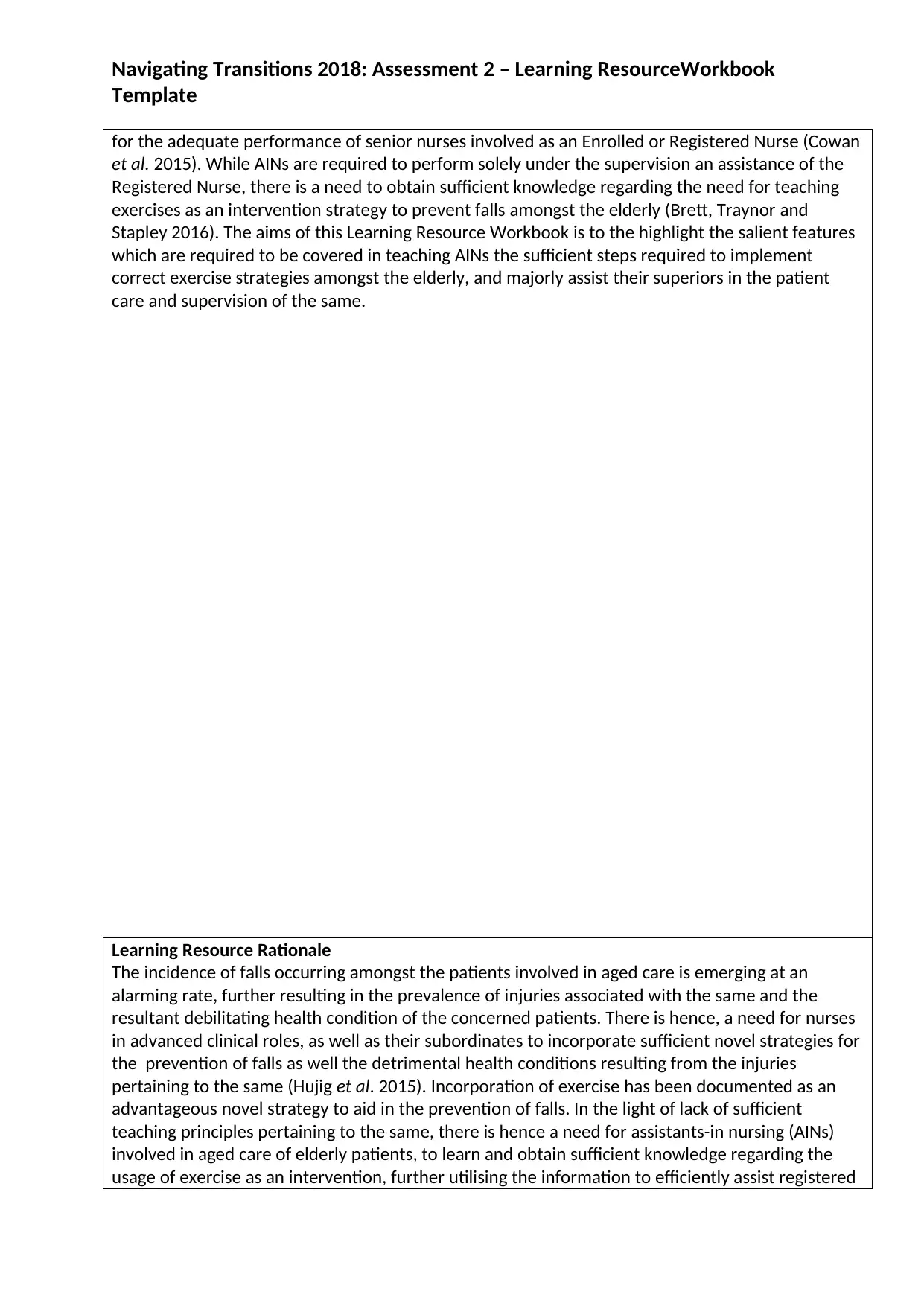
Navigating Transitions 2018: Assessment 2 – Learning ResourceWorkbook
Template
for the adequate performance of senior nurses involved as an Enrolled or Registered Nurse (Cowan
et al. 2015). While AINs are required to perform solely under the supervision an assistance of the
Registered Nurse, there is a need to obtain sufficient knowledge regarding the need for teaching
exercises as an intervention strategy to prevent falls amongst the elderly (Brett, Traynor and
Stapley 2016). The aims of this Learning Resource Workbook is to the highlight the salient features
which are required to be covered in teaching AINs the sufficient steps required to implement
correct exercise strategies amongst the elderly, and majorly assist their superiors in the patient
care and supervision of the same.
Learning Resource Rationale
The incidence of falls occurring amongst the patients involved in aged care is emerging at an
alarming rate, further resulting in the prevalence of injuries associated with the same and the
resultant debilitating health condition of the concerned patients. There is hence, a need for nurses
in advanced clinical roles, as well as their subordinates to incorporate sufficient novel strategies for
the prevention of falls as well the detrimental health conditions resulting from the injuries
pertaining to the same (Hujig et al. 2015). Incorporation of exercise has been documented as an
advantageous novel strategy to aid in the prevention of falls. In the light of lack of sufficient
teaching principles pertaining to the same, there is hence a need for assistants-in nursing (AINs)
involved in aged care of elderly patients, to learn and obtain sufficient knowledge regarding the
usage of exercise as an intervention, further utilising the information to efficiently assist registered
Template
for the adequate performance of senior nurses involved as an Enrolled or Registered Nurse (Cowan
et al. 2015). While AINs are required to perform solely under the supervision an assistance of the
Registered Nurse, there is a need to obtain sufficient knowledge regarding the need for teaching
exercises as an intervention strategy to prevent falls amongst the elderly (Brett, Traynor and
Stapley 2016). The aims of this Learning Resource Workbook is to the highlight the salient features
which are required to be covered in teaching AINs the sufficient steps required to implement
correct exercise strategies amongst the elderly, and majorly assist their superiors in the patient
care and supervision of the same.
Learning Resource Rationale
The incidence of falls occurring amongst the patients involved in aged care is emerging at an
alarming rate, further resulting in the prevalence of injuries associated with the same and the
resultant debilitating health condition of the concerned patients. There is hence, a need for nurses
in advanced clinical roles, as well as their subordinates to incorporate sufficient novel strategies for
the prevention of falls as well the detrimental health conditions resulting from the injuries
pertaining to the same (Hujig et al. 2015). Incorporation of exercise has been documented as an
advantageous novel strategy to aid in the prevention of falls. In the light of lack of sufficient
teaching principles pertaining to the same, there is hence a need for assistants-in nursing (AINs)
involved in aged care of elderly patients, to learn and obtain sufficient knowledge regarding the
usage of exercise as an intervention, further utilising the information to efficiently assist registered
⊘ This is a preview!⊘
Do you want full access?
Subscribe today to unlock all pages.

Trusted by 1+ million students worldwide
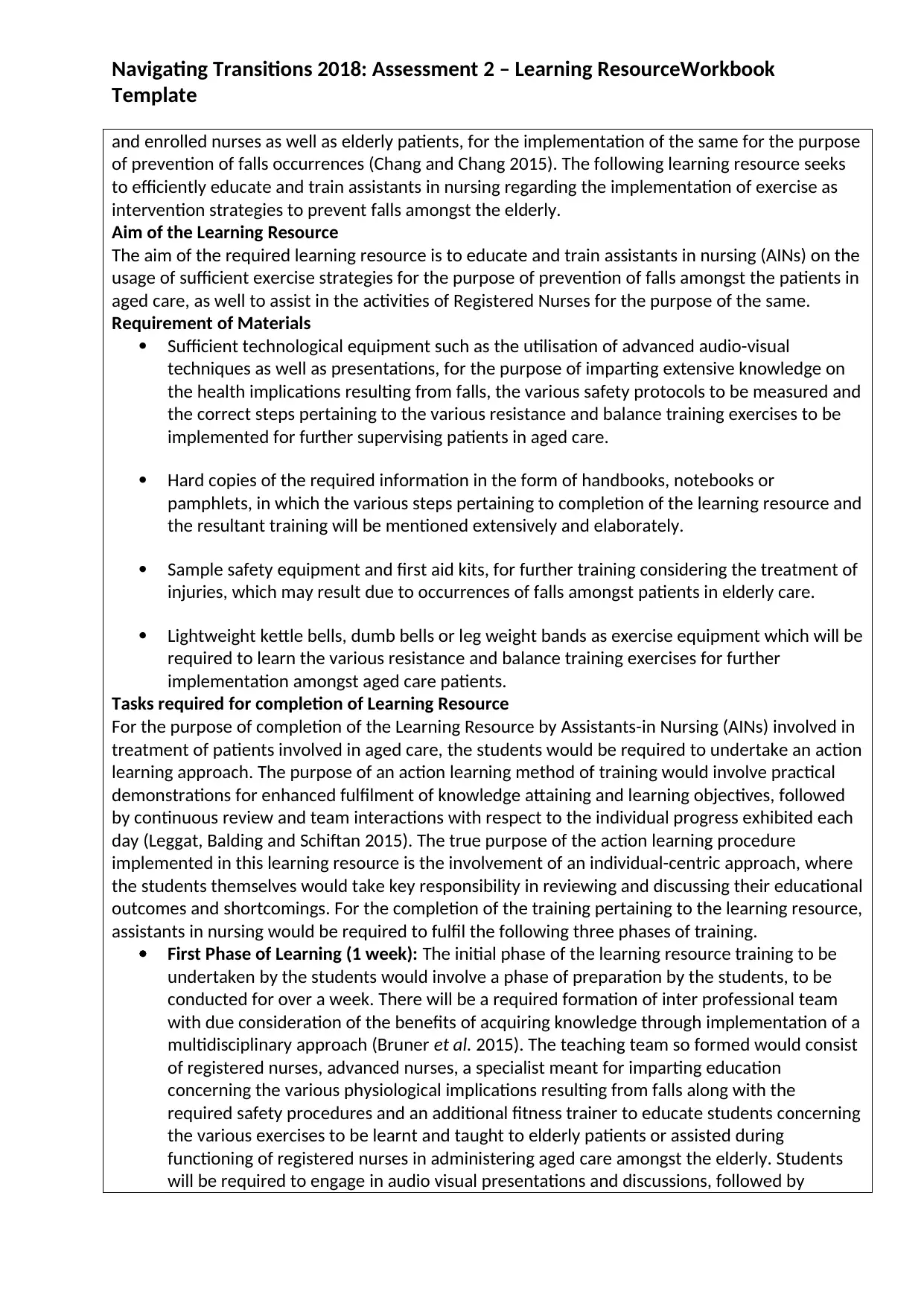
Navigating Transitions 2018: Assessment 2 – Learning ResourceWorkbook
Template
and enrolled nurses as well as elderly patients, for the implementation of the same for the purpose
of prevention of falls occurrences (Chang and Chang 2015). The following learning resource seeks
to efficiently educate and train assistants in nursing regarding the implementation of exercise as
intervention strategies to prevent falls amongst the elderly.
Aim of the Learning Resource
The aim of the required learning resource is to educate and train assistants in nursing (AINs) on the
usage of sufficient exercise strategies for the purpose of prevention of falls amongst the patients in
aged care, as well to assist in the activities of Registered Nurses for the purpose of the same.
Requirement of Materials
Sufficient technological equipment such as the utilisation of advanced audio-visual
techniques as well as presentations, for the purpose of imparting extensive knowledge on
the health implications resulting from falls, the various safety protocols to be measured and
the correct steps pertaining to the various resistance and balance training exercises to be
implemented for further supervising patients in aged care.
Hard copies of the required information in the form of handbooks, notebooks or
pamphlets, in which the various steps pertaining to completion of the learning resource and
the resultant training will be mentioned extensively and elaborately.
Sample safety equipment and first aid kits, for further training considering the treatment of
injuries, which may result due to occurrences of falls amongst patients in elderly care.
Lightweight kettle bells, dumb bells or leg weight bands as exercise equipment which will be
required to learn the various resistance and balance training exercises for further
implementation amongst aged care patients.
Tasks required for completion of Learning Resource
For the purpose of completion of the Learning Resource by Assistants-in Nursing (AINs) involved in
treatment of patients involved in aged care, the students would be required to undertake an action
learning approach. The purpose of an action learning method of training would involve practical
demonstrations for enhanced fulfilment of knowledge attaining and learning objectives, followed
by continuous review and team interactions with respect to the individual progress exhibited each
day (Leggat, Balding and Schiftan 2015). The true purpose of the action learning procedure
implemented in this learning resource is the involvement of an individual-centric approach, where
the students themselves would take key responsibility in reviewing and discussing their educational
outcomes and shortcomings. For the completion of the training pertaining to the learning resource,
assistants in nursing would be required to fulfil the following three phases of training.
First Phase of Learning (1 week): The initial phase of the learning resource training to be
undertaken by the students would involve a phase of preparation by the students, to be
conducted for over a week. There will be a required formation of inter professional team
with due consideration of the benefits of acquiring knowledge through implementation of a
multidisciplinary approach (Bruner et al. 2015). The teaching team so formed would consist
of registered nurses, advanced nurses, a specialist meant for imparting education
concerning the various physiological implications resulting from falls along with the
required safety procedures and an additional fitness trainer to educate students concerning
the various exercises to be learnt and taught to elderly patients or assisted during
functioning of registered nurses in administering aged care amongst the elderly. Students
will be required to engage in audio visual presentations and discussions, followed by
Template
and enrolled nurses as well as elderly patients, for the implementation of the same for the purpose
of prevention of falls occurrences (Chang and Chang 2015). The following learning resource seeks
to efficiently educate and train assistants in nursing regarding the implementation of exercise as
intervention strategies to prevent falls amongst the elderly.
Aim of the Learning Resource
The aim of the required learning resource is to educate and train assistants in nursing (AINs) on the
usage of sufficient exercise strategies for the purpose of prevention of falls amongst the patients in
aged care, as well to assist in the activities of Registered Nurses for the purpose of the same.
Requirement of Materials
Sufficient technological equipment such as the utilisation of advanced audio-visual
techniques as well as presentations, for the purpose of imparting extensive knowledge on
the health implications resulting from falls, the various safety protocols to be measured and
the correct steps pertaining to the various resistance and balance training exercises to be
implemented for further supervising patients in aged care.
Hard copies of the required information in the form of handbooks, notebooks or
pamphlets, in which the various steps pertaining to completion of the learning resource and
the resultant training will be mentioned extensively and elaborately.
Sample safety equipment and first aid kits, for further training considering the treatment of
injuries, which may result due to occurrences of falls amongst patients in elderly care.
Lightweight kettle bells, dumb bells or leg weight bands as exercise equipment which will be
required to learn the various resistance and balance training exercises for further
implementation amongst aged care patients.
Tasks required for completion of Learning Resource
For the purpose of completion of the Learning Resource by Assistants-in Nursing (AINs) involved in
treatment of patients involved in aged care, the students would be required to undertake an action
learning approach. The purpose of an action learning method of training would involve practical
demonstrations for enhanced fulfilment of knowledge attaining and learning objectives, followed
by continuous review and team interactions with respect to the individual progress exhibited each
day (Leggat, Balding and Schiftan 2015). The true purpose of the action learning procedure
implemented in this learning resource is the involvement of an individual-centric approach, where
the students themselves would take key responsibility in reviewing and discussing their educational
outcomes and shortcomings. For the completion of the training pertaining to the learning resource,
assistants in nursing would be required to fulfil the following three phases of training.
First Phase of Learning (1 week): The initial phase of the learning resource training to be
undertaken by the students would involve a phase of preparation by the students, to be
conducted for over a week. There will be a required formation of inter professional team
with due consideration of the benefits of acquiring knowledge through implementation of a
multidisciplinary approach (Bruner et al. 2015). The teaching team so formed would consist
of registered nurses, advanced nurses, a specialist meant for imparting education
concerning the various physiological implications resulting from falls along with the
required safety procedures and an additional fitness trainer to educate students concerning
the various exercises to be learnt and taught to elderly patients or assisted during
functioning of registered nurses in administering aged care amongst the elderly. Students
will be required to engage in audio visual presentations and discussions, followed by
Paraphrase This Document
Need a fresh take? Get an instant paraphrase of this document with our AI Paraphraser
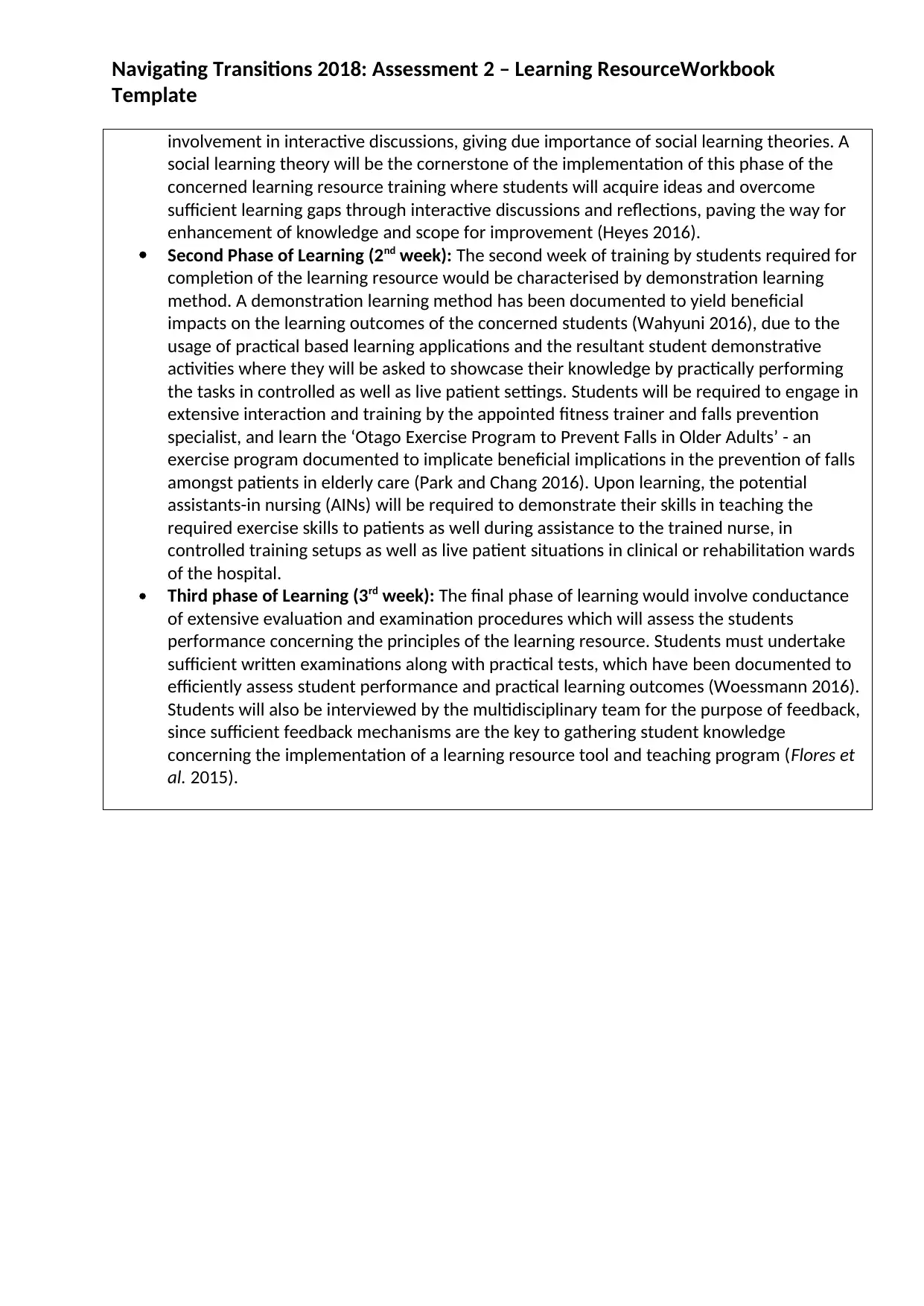
Navigating Transitions 2018: Assessment 2 – Learning ResourceWorkbook
Template
involvement in interactive discussions, giving due importance of social learning theories. A
social learning theory will be the cornerstone of the implementation of this phase of the
concerned learning resource training where students will acquire ideas and overcome
sufficient learning gaps through interactive discussions and reflections, paving the way for
enhancement of knowledge and scope for improvement (Heyes 2016).
Second Phase of Learning (2nd week): The second week of training by students required for
completion of the learning resource would be characterised by demonstration learning
method. A demonstration learning method has been documented to yield beneficial
impacts on the learning outcomes of the concerned students (Wahyuni 2016), due to the
usage of practical based learning applications and the resultant student demonstrative
activities where they will be asked to showcase their knowledge by practically performing
the tasks in controlled as well as live patient settings. Students will be required to engage in
extensive interaction and training by the appointed fitness trainer and falls prevention
specialist, and learn the ‘Otago Exercise Program to Prevent Falls in Older Adults’ - an
exercise program documented to implicate beneficial implications in the prevention of falls
amongst patients in elderly care (Park and Chang 2016). Upon learning, the potential
assistants-in nursing (AINs) will be required to demonstrate their skills in teaching the
required exercise skills to patients as well during assistance to the trained nurse, in
controlled training setups as well as live patient situations in clinical or rehabilitation wards
of the hospital.
Third phase of Learning (3rd week): The final phase of learning would involve conductance
of extensive evaluation and examination procedures which will assess the students
performance concerning the principles of the learning resource. Students must undertake
sufficient written examinations along with practical tests, which have been documented to
efficiently assess student performance and practical learning outcomes (Woessmann 2016).
Students will also be interviewed by the multidisciplinary team for the purpose of feedback,
since sufficient feedback mechanisms are the key to gathering student knowledge
concerning the implementation of a learning resource tool and teaching program (Flores et
al. 2015).
Template
involvement in interactive discussions, giving due importance of social learning theories. A
social learning theory will be the cornerstone of the implementation of this phase of the
concerned learning resource training where students will acquire ideas and overcome
sufficient learning gaps through interactive discussions and reflections, paving the way for
enhancement of knowledge and scope for improvement (Heyes 2016).
Second Phase of Learning (2nd week): The second week of training by students required for
completion of the learning resource would be characterised by demonstration learning
method. A demonstration learning method has been documented to yield beneficial
impacts on the learning outcomes of the concerned students (Wahyuni 2016), due to the
usage of practical based learning applications and the resultant student demonstrative
activities where they will be asked to showcase their knowledge by practically performing
the tasks in controlled as well as live patient settings. Students will be required to engage in
extensive interaction and training by the appointed fitness trainer and falls prevention
specialist, and learn the ‘Otago Exercise Program to Prevent Falls in Older Adults’ - an
exercise program documented to implicate beneficial implications in the prevention of falls
amongst patients in elderly care (Park and Chang 2016). Upon learning, the potential
assistants-in nursing (AINs) will be required to demonstrate their skills in teaching the
required exercise skills to patients as well during assistance to the trained nurse, in
controlled training setups as well as live patient situations in clinical or rehabilitation wards
of the hospital.
Third phase of Learning (3rd week): The final phase of learning would involve conductance
of extensive evaluation and examination procedures which will assess the students
performance concerning the principles of the learning resource. Students must undertake
sufficient written examinations along with practical tests, which have been documented to
efficiently assess student performance and practical learning outcomes (Woessmann 2016).
Students will also be interviewed by the multidisciplinary team for the purpose of feedback,
since sufficient feedback mechanisms are the key to gathering student knowledge
concerning the implementation of a learning resource tool and teaching program (Flores et
al. 2015).
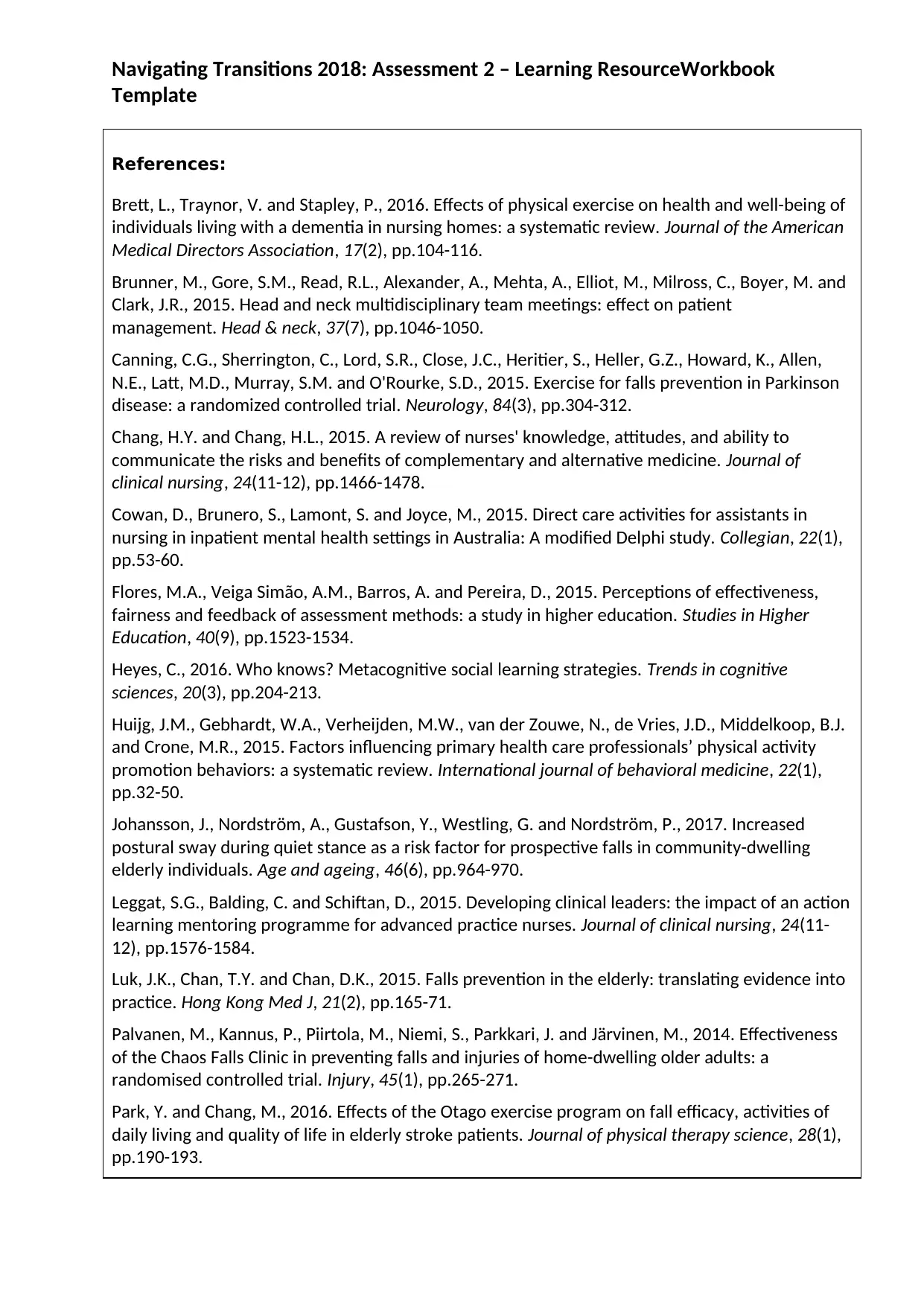
Navigating Transitions 2018: Assessment 2 – Learning ResourceWorkbook
Template
References:
Brett, L., Traynor, V. and Stapley, P., 2016. Effects of physical exercise on health and well-being of
individuals living with a dementia in nursing homes: a systematic review. Journal of the American
Medical Directors Association, 17(2), pp.104-116.
Brunner, M., Gore, S.M., Read, R.L., Alexander, A., Mehta, A., Elliot, M., Milross, C., Boyer, M. and
Clark, J.R., 2015. Head and neck multidisciplinary team meetings: effect on patient
management. Head & neck, 37(7), pp.1046-1050.
Canning, C.G., Sherrington, C., Lord, S.R., Close, J.C., Heritier, S., Heller, G.Z., Howard, K., Allen,
N.E., Latt, M.D., Murray, S.M. and O'Rourke, S.D., 2015. Exercise for falls prevention in Parkinson
disease: a randomized controlled trial. Neurology, 84(3), pp.304-312.
Chang, H.Y. and Chang, H.L., 2015. A review of nurses' knowledge, attitudes, and ability to
communicate the risks and benefits of complementary and alternative medicine. Journal of
clinical nursing, 24(11-12), pp.1466-1478.
Cowan, D., Brunero, S., Lamont, S. and Joyce, M., 2015. Direct care activities for assistants in
nursing in inpatient mental health settings in Australia: A modified Delphi study. Collegian, 22(1),
pp.53-60.
Flores, M.A., Veiga Simão, A.M., Barros, A. and Pereira, D., 2015. Perceptions of effectiveness,
fairness and feedback of assessment methods: a study in higher education. Studies in Higher
Education, 40(9), pp.1523-1534.
Heyes, C., 2016. Who knows? Metacognitive social learning strategies. Trends in cognitive
sciences, 20(3), pp.204-213.
Huijg, J.M., Gebhardt, W.A., Verheijden, M.W., van der Zouwe, N., de Vries, J.D., Middelkoop, B.J.
and Crone, M.R., 2015. Factors influencing primary health care professionals’ physical activity
promotion behaviors: a systematic review. International journal of behavioral medicine, 22(1),
pp.32-50.
Johansson, J., Nordström, A., Gustafson, Y., Westling, G. and Nordström, P., 2017. Increased
postural sway during quiet stance as a risk factor for prospective falls in community-dwelling
elderly individuals. Age and ageing, 46(6), pp.964-970.
Leggat, S.G., Balding, C. and Schiftan, D., 2015. Developing clinical leaders: the impact of an action
learning mentoring programme for advanced practice nurses. Journal of clinical nursing, 24(11-
12), pp.1576-1584.
Luk, J.K., Chan, T.Y. and Chan, D.K., 2015. Falls prevention in the elderly: translating evidence into
practice. Hong Kong Med J, 21(2), pp.165-71.
Palvanen, M., Kannus, P., Piirtola, M., Niemi, S., Parkkari, J. and Järvinen, M., 2014. Effectiveness
of the Chaos Falls Clinic in preventing falls and injuries of home-dwelling older adults: a
randomised controlled trial. Injury, 45(1), pp.265-271.
Park, Y. and Chang, M., 2016. Effects of the Otago exercise program on fall efficacy, activities of
daily living and quality of life in elderly stroke patients. Journal of physical therapy science, 28(1),
pp.190-193.
Template
References:
Brett, L., Traynor, V. and Stapley, P., 2016. Effects of physical exercise on health and well-being of
individuals living with a dementia in nursing homes: a systematic review. Journal of the American
Medical Directors Association, 17(2), pp.104-116.
Brunner, M., Gore, S.M., Read, R.L., Alexander, A., Mehta, A., Elliot, M., Milross, C., Boyer, M. and
Clark, J.R., 2015. Head and neck multidisciplinary team meetings: effect on patient
management. Head & neck, 37(7), pp.1046-1050.
Canning, C.G., Sherrington, C., Lord, S.R., Close, J.C., Heritier, S., Heller, G.Z., Howard, K., Allen,
N.E., Latt, M.D., Murray, S.M. and O'Rourke, S.D., 2015. Exercise for falls prevention in Parkinson
disease: a randomized controlled trial. Neurology, 84(3), pp.304-312.
Chang, H.Y. and Chang, H.L., 2015. A review of nurses' knowledge, attitudes, and ability to
communicate the risks and benefits of complementary and alternative medicine. Journal of
clinical nursing, 24(11-12), pp.1466-1478.
Cowan, D., Brunero, S., Lamont, S. and Joyce, M., 2015. Direct care activities for assistants in
nursing in inpatient mental health settings in Australia: A modified Delphi study. Collegian, 22(1),
pp.53-60.
Flores, M.A., Veiga Simão, A.M., Barros, A. and Pereira, D., 2015. Perceptions of effectiveness,
fairness and feedback of assessment methods: a study in higher education. Studies in Higher
Education, 40(9), pp.1523-1534.
Heyes, C., 2016. Who knows? Metacognitive social learning strategies. Trends in cognitive
sciences, 20(3), pp.204-213.
Huijg, J.M., Gebhardt, W.A., Verheijden, M.W., van der Zouwe, N., de Vries, J.D., Middelkoop, B.J.
and Crone, M.R., 2015. Factors influencing primary health care professionals’ physical activity
promotion behaviors: a systematic review. International journal of behavioral medicine, 22(1),
pp.32-50.
Johansson, J., Nordström, A., Gustafson, Y., Westling, G. and Nordström, P., 2017. Increased
postural sway during quiet stance as a risk factor for prospective falls in community-dwelling
elderly individuals. Age and ageing, 46(6), pp.964-970.
Leggat, S.G., Balding, C. and Schiftan, D., 2015. Developing clinical leaders: the impact of an action
learning mentoring programme for advanced practice nurses. Journal of clinical nursing, 24(11-
12), pp.1576-1584.
Luk, J.K., Chan, T.Y. and Chan, D.K., 2015. Falls prevention in the elderly: translating evidence into
practice. Hong Kong Med J, 21(2), pp.165-71.
Palvanen, M., Kannus, P., Piirtola, M., Niemi, S., Parkkari, J. and Järvinen, M., 2014. Effectiveness
of the Chaos Falls Clinic in preventing falls and injuries of home-dwelling older adults: a
randomised controlled trial. Injury, 45(1), pp.265-271.
Park, Y. and Chang, M., 2016. Effects of the Otago exercise program on fall efficacy, activities of
daily living and quality of life in elderly stroke patients. Journal of physical therapy science, 28(1),
pp.190-193.
⊘ This is a preview!⊘
Do you want full access?
Subscribe today to unlock all pages.

Trusted by 1+ million students worldwide
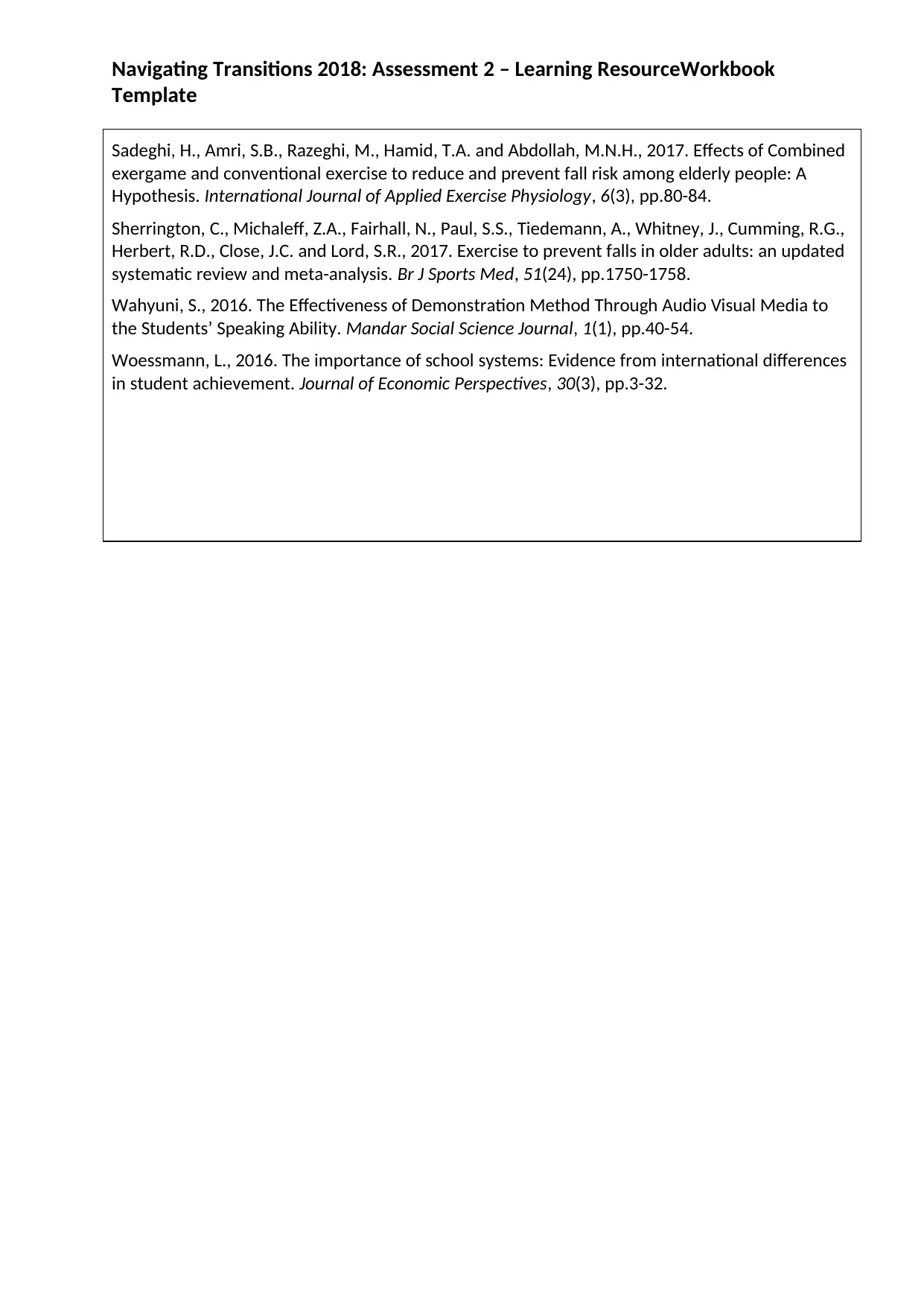
Navigating Transitions 2018: Assessment 2 – Learning ResourceWorkbook
Template
Sadeghi, H., Amri, S.B., Razeghi, M., Hamid, T.A. and Abdollah, M.N.H., 2017. Effects of Combined
exergame and conventional exercise to reduce and prevent fall risk among elderly people: A
Hypothesis. International Journal of Applied Exercise Physiology, 6(3), pp.80-84.
Sherrington, C., Michaleff, Z.A., Fairhall, N., Paul, S.S., Tiedemann, A., Whitney, J., Cumming, R.G.,
Herbert, R.D., Close, J.C. and Lord, S.R., 2017. Exercise to prevent falls in older adults: an updated
systematic review and meta-analysis. Br J Sports Med, 51(24), pp.1750-1758.
Wahyuni, S., 2016. The Effectiveness of Demonstration Method Through Audio Visual Media to
the Students’ Speaking Ability. Mandar Social Science Journal, 1(1), pp.40-54.
Woessmann, L., 2016. The importance of school systems: Evidence from international differences
in student achievement. Journal of Economic Perspectives, 30(3), pp.3-32.
Template
Sadeghi, H., Amri, S.B., Razeghi, M., Hamid, T.A. and Abdollah, M.N.H., 2017. Effects of Combined
exergame and conventional exercise to reduce and prevent fall risk among elderly people: A
Hypothesis. International Journal of Applied Exercise Physiology, 6(3), pp.80-84.
Sherrington, C., Michaleff, Z.A., Fairhall, N., Paul, S.S., Tiedemann, A., Whitney, J., Cumming, R.G.,
Herbert, R.D., Close, J.C. and Lord, S.R., 2017. Exercise to prevent falls in older adults: an updated
systematic review and meta-analysis. Br J Sports Med, 51(24), pp.1750-1758.
Wahyuni, S., 2016. The Effectiveness of Demonstration Method Through Audio Visual Media to
the Students’ Speaking Ability. Mandar Social Science Journal, 1(1), pp.40-54.
Woessmann, L., 2016. The importance of school systems: Evidence from international differences
in student achievement. Journal of Economic Perspectives, 30(3), pp.3-32.
1 out of 7
Related Documents
Your All-in-One AI-Powered Toolkit for Academic Success.
+13062052269
info@desklib.com
Available 24*7 on WhatsApp / Email
![[object Object]](/_next/static/media/star-bottom.7253800d.svg)
Unlock your academic potential
© 2024 | Zucol Services PVT LTD | All rights reserved.




